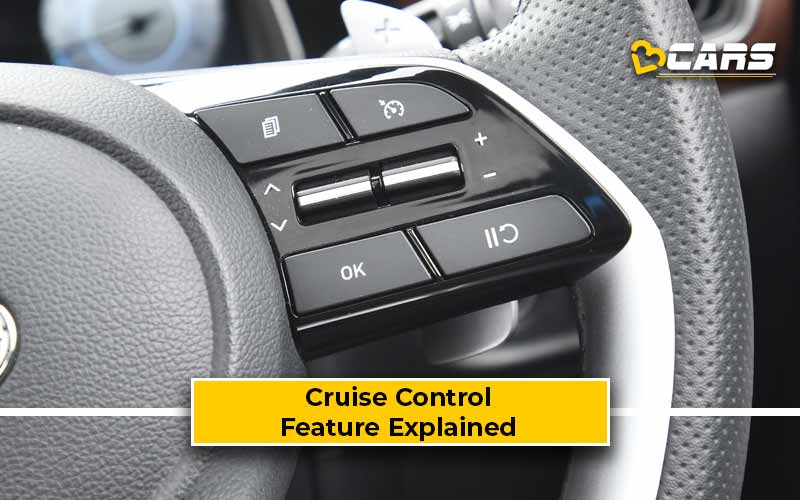Cruise Control - Feature, Pros & Cons, Working Explained
In this Feature Explained article, we’ll present the most detailed analysis of the cruise control feature in your car. We’ll list out the pros and cons of cruise control, explain how it works, provide the typical cost of getting the cruise control feature from the aftermarket and its repair and replacement costs. Based on this analysis, you can decide the importance of this feature for your car ownership experience.

We have also included a list of affordable cars in India with cruise control to help you make informed purchasing decisions.
What Are The Pros And Cons Of Cruise Control?
Cruise control, the automotive equivalent of a rice cooker, can be a blessing on long highway drives. But like any powerful tool, it comes with its own set of challenges. Let's dive into the pros and cons of using cruise control to help you decide if it's the right fit for your driving style.
The pros or advantages of cruise control are:
- Effortless Speed: Say goodbye to constant foot adjustments! Cruise control maintains your desired speed, reducing fatigue and leg strain on long journeys. Think of it as an extended chai break for your feet.
- Fuel Efficiency Friend: Consistent speed translates to optimal fuel economy. Cruise control minimises unnecessary acceleration and braking, leading to potentially improved mileage.
- Highway Hero: On open roads with steady traffic flow, cruise control takes the edge off long drives. It can help you avoid unintentional speeding and keeps you relaxed, making the journey less stressful.
The cons or disadvantages of cruise control are:
- Drowsiness Danger: The hypnotic hum of constant speed can lull even the most alert driver into a false sense of security. Remember, cruise control doesn't replace the need for active engagement and vigilance.
- Road Reality Check: Cruise control isn't a one-size-fits-all solution. It struggles on winding roads, highways with varying speed limits, or unpredictable conditions. Be prepared to disengage quickly when the road throws you a curveball.
- Distraction Magnet: With your foot off the throttle, it's tempting to multitask or zone out. Remember, you're still the captain of the ship! Stay focused on the road and keep your eyes peeled for potential hazards.
Remember: Cruise control is a tool, not a magic spell. Use it responsibly, stay alert, and be prepared to take the wheel when needed.
What Is Cruise Control?
Forget aching legs and a leaden foot! Cruise control is your saviour on long highway journeys, taking over the tedious job of maintaining speed and letting you relax behind the wheel. Here's how to turn this helpful feature into your highway driving ally:
1. Autopilot Engaged: Ditch the constant pedalling. Cruise control lets you set a desired speed, then handles the throttle input, keeping you cruising effortlessly.
2. Safety First: Cruise control isn't autopilot! Cruise control disengages when you tap the brake, ensuring you're always in control. Just remember to manually reactivate it if you want to pick up the pace again.
3. Fine-Tuning Your Cruise: Feeling a little fast or slow? The "+" and "-" buttons are your speed adjustment tools. Need a quick burst to pass? Simply press the accelerator, and cruise control temporarily suspends itself.
4. Weather Wise: While cruise control is perfect for smooth highways, remember it's not your all-weather companion. Heavy rain, low visibility, or unpredictable conditions are best tackled with good old-fashioned manual driving.
5. Know Your Controls: Before hitting the road, familiarise yourself with your car's specific cruise control buttons. Consult your owner's manual to avoid fumbling while driving.
Cruise control isn't just for long hauls anymore. It's your highway driving hero, reducing fatigue, improving fuel efficiency, and letting you enjoy the journey.
How Does Cruise Control Work?
Modern cars that ply our roads today have drive-by-wire accelerators. This means that our inputs on the accelerator pedal only provide an electrical signal to the car's on-board computers. These clever conductors then interpret your signal, determining the ideal fuel-air mixture to reach your desired speed.
Now, enter cruise control. In a car equipped with this feature, the computers store this "desired speed" as their baseline. They continuously monitor your actual speed using sensors on the wheels. Any deviation up or down triggers a micro-adjustment in the fuel-air mixture, gently nudging the car back to accelerate or decelerate as required.
How Expensive Is It To Repair Or Replace Cruise Control?
The cruise control feature does not typically fail as this is a software-based feature. At best, the only costs associated with maintaining the cruise control feature in your car is if you have somehow managed to break the cruise control stalk or the buttons on the steering wheel that lets you activate this feature. In such instances, you will need to replace the switchgear, which could cost you up to Rs. 15,000 - Rs. 20,000.
Ultimately, the cost of repairing or replacing cruise control can vary widely depending on several factors, including:
- The extent of the problem: Is it a minor issue like a faulty switch or a major malfunction of the control module? More complex repairs will naturally be more expensive.
- Your car's make and model: Different car models have different cruise control systems and parts, with some being more costly than others.
- Labour costs: The location and rates of the repair shop you choose will affect the labour cost involved.
- Whether you choose original parts or aftermarket replacements: Generally, original parts are more expensive than aftermarket options, but they may also be of higher quality and offer better compatibility.
Here are some tips for minimising the cost:
- Get a diagnosis: Before committing to any repairs, have a qualified mechanic diagnose the problem to determine the exact cause and the associated cost.
- Shop around: Compare prices from different repair shops to find the best deal.
- Consider aftermarket parts: For minor repairs, using high-quality aftermarket parts can be a more affordable option.
- Check your warranty: Some car warranties may cover cruise control repairs or replacements.
What Is The Cost Of Aftermarket Cruise Control?
Adding aftermarket cruise control might seem tempting, but consider the pitfalls before installing an aftermarket kit. Here's why factory-fitted cruise control is the smoother and safer route:
1. Installation: Installing aftermarket cruise control, especially in cars without existing variants featuring it, can be a technical challenge. Incompatible parts, complex wiring, and modifications to the steering wheel or steering column can lead to frustration and potential malfunctions.
2. Safety First, Always: Cruise control manages your car's speed, making its performance critical. Opting for an aftermarket solution introduces potential risks as compatibility and quality might not match manufacturer standards, jeopardising your safety and vehicle stability.
3. Warranty Woes: Installing aftermarket cruise control often voids your car's manufacturer warranty. That means any issues arising from the add-on become your responsibility, potentially leading to costly repairs.
4. Factory Finesse: Choosing a car with factory-installed cruise control offers peace of mind. These systems are seamlessly integrated with your car's electronics, ensuring optimal performance, compatibility, and most importantly, safety.
How Easy Or Complex Is It To Install Cruise Control?
The cruise control feature comes fitted from the factory. It is nearly impossible to add this feature once you have bought a car that does not have cruise control. However, if you have broken the controls to this feature, replacing the cruise control stalks or the steering wheel switchgear could take between 3-5 hours depending on the proficiency of the mechanic working on your car. We recommend carrying out such repairs at authorised service centres only.
What Are Some Affordable Cars In India With Cruise Control?
Here are the cars and their variants priced under Rs. 10.0 lakh that offer cruise control in India:
- Hyundai Grand i10 Nios Sportz
- Tata Punch Accomplished
- Hyundai Aura SX
- Tata Altroz XT
- Hyundai Exter SX
- Maruti Suzuki Swift ZXI Plus
- Hyundai i20 Sportz
- Nissan Magnite XV Premium
- Honda Amaze VX
- Maruti Suzuki Dzire SXI
- Maruti Suzuki Baleno Alpha
- Toyota Glanza V
- Maruti Suzuki Ciaz Delta
- Hyundai i20 N Line N6
- Renault Kiger RXZ
Note: Check your car’s fuel cost with Fuel Cost Calculator in India
Verdict - Should I Get Cruise Control From The Aftermarket?
The cruise control feature is nearly impossible to install from the aftermarket if none of the variants of your car have this feature. Even if you find a workshop willing to take up this job, be warned that this will be installed using aftermarket kits that aren’t tested or calibrated by your car’s manufacturer. Hence, we recommend spending a bit more and buying the variant that offers this feature. Cruise control is especially useful for car owners who frequently drive on the highways. However, if you mostly drive within the city, then you can skip this feature altogether.
Note: Check your Car EMI with our - Car Loan EMI Calculator


Maruti brezza zdi cruise installation
Balino 2016 automatic Give me price cruse control